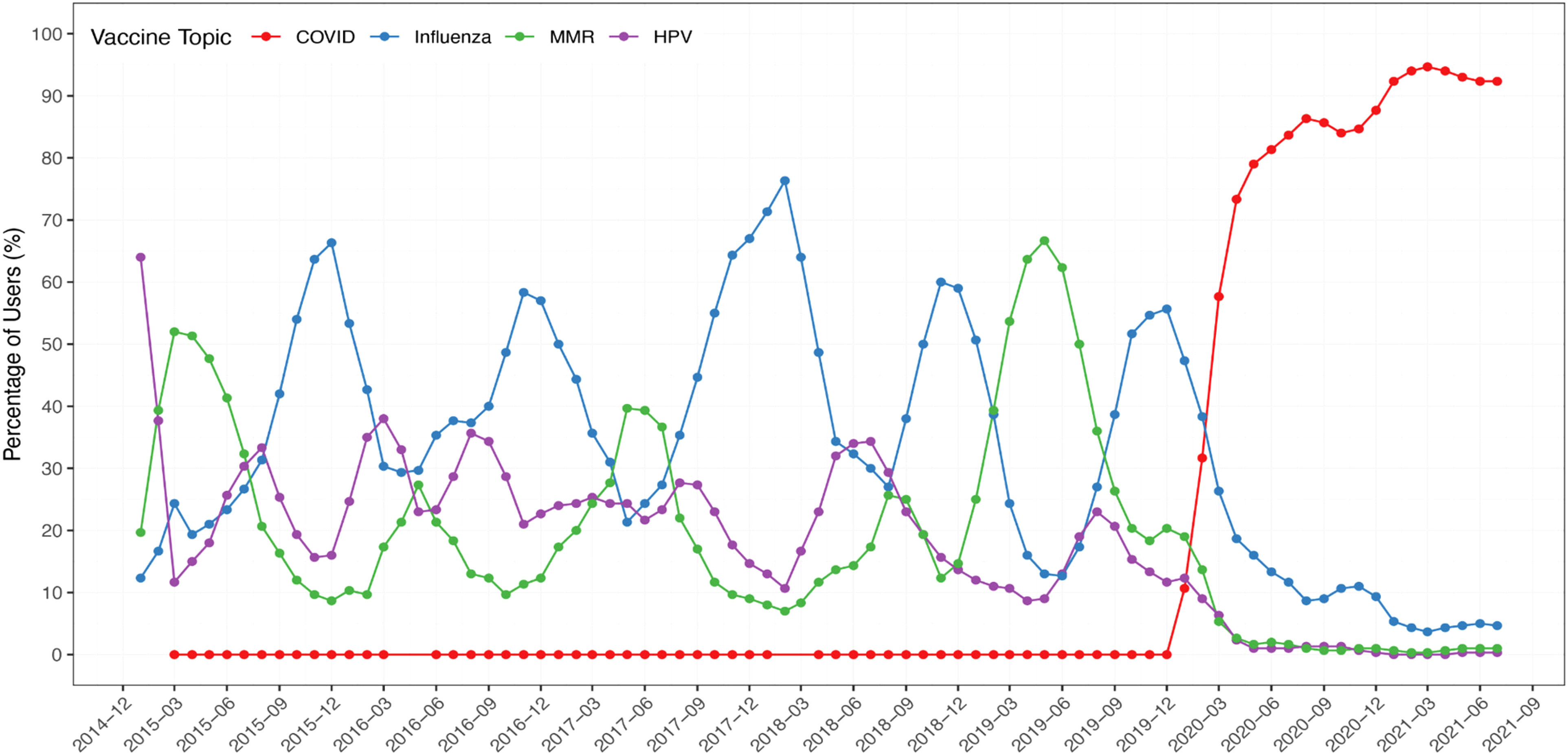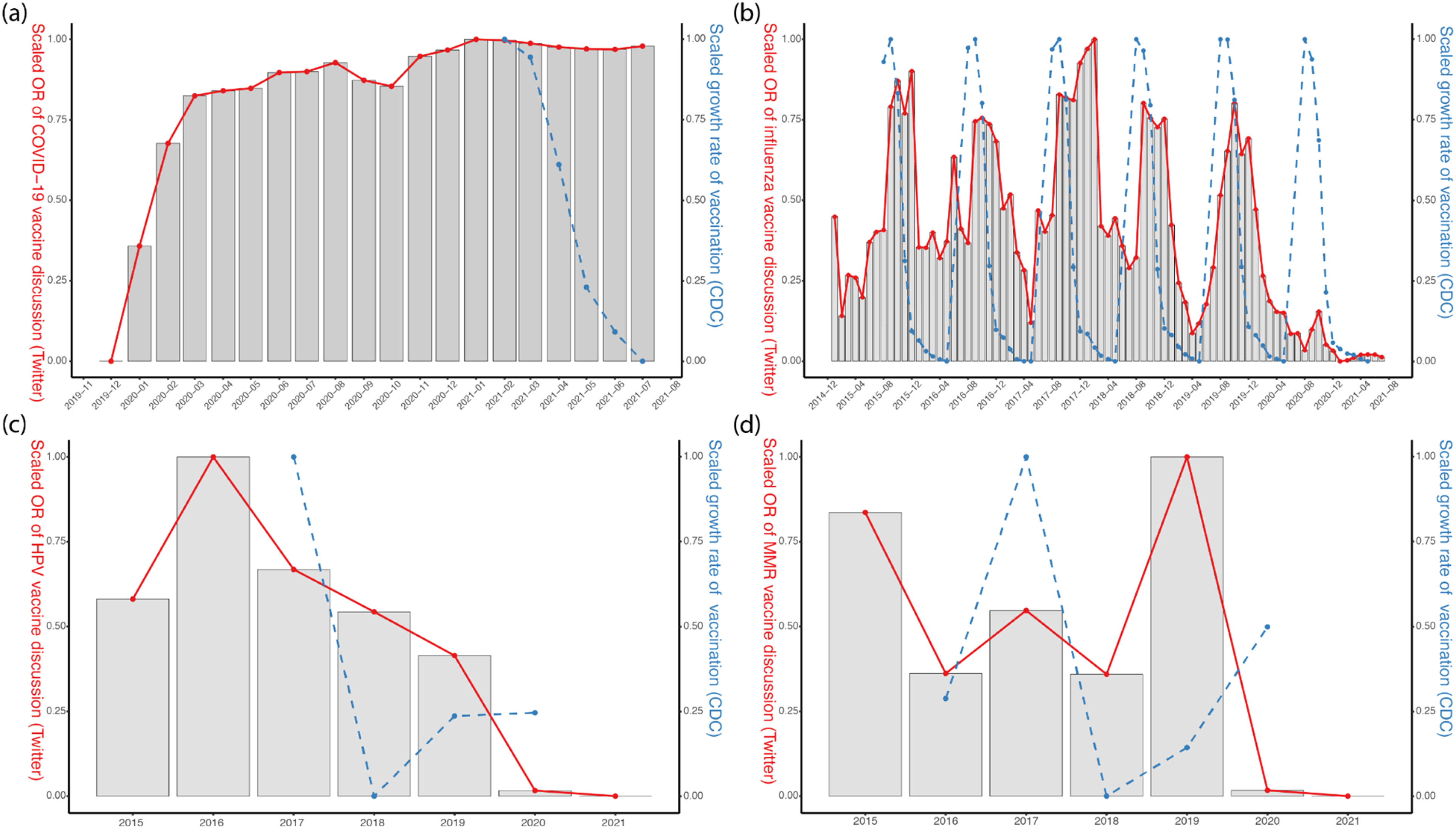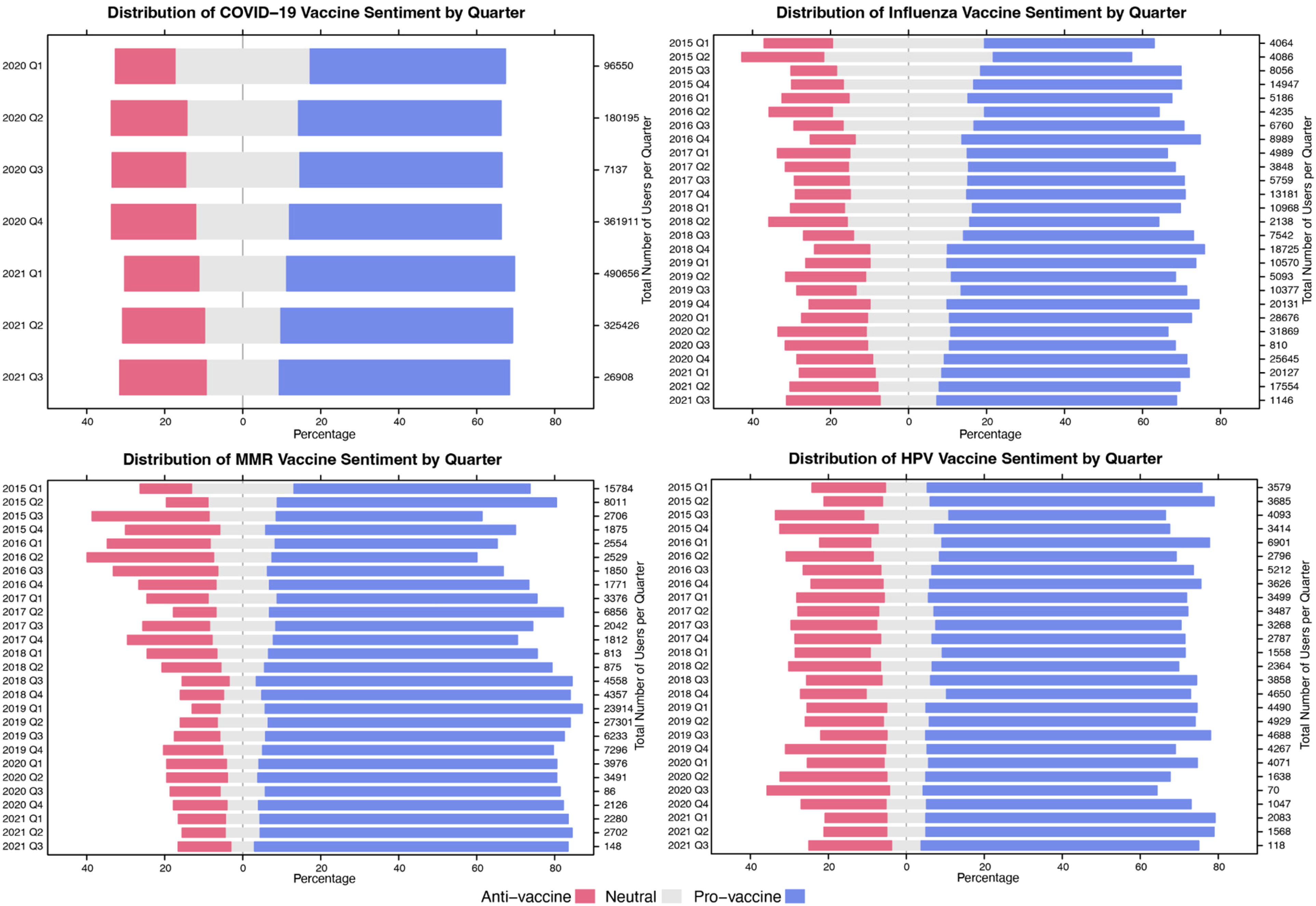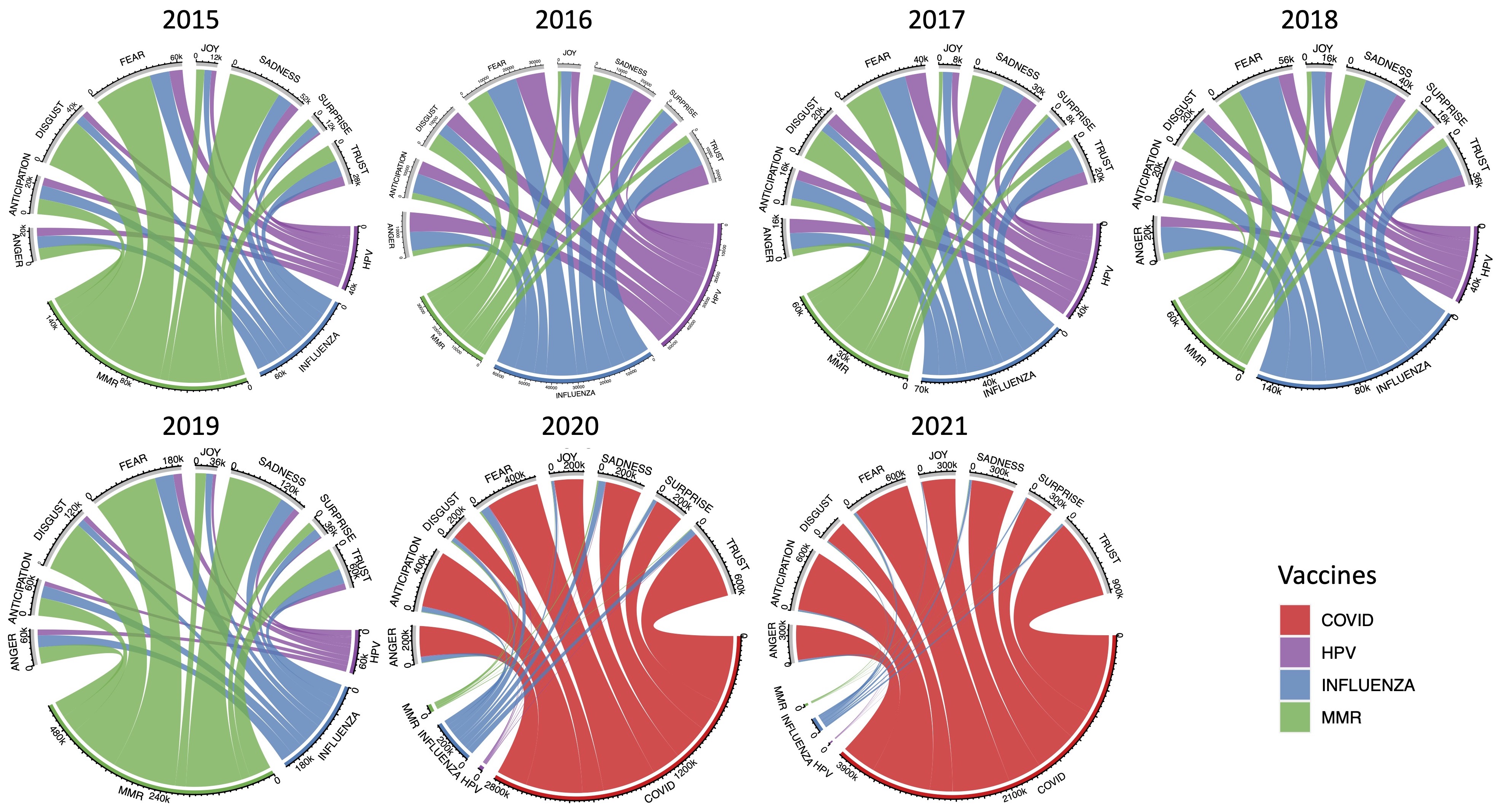Vaccine comparison
A comparison between online social media discussions and vaccination rates - A tale of four vaccines
The recent COVID-19 pandemic has brought the debate around vaccinations to the forefront of public discussion. In this discussion, various social media platforms have a key role. While this has long been recognized, the way by which the public assigns attention to such topics remains largely unknown. Furthermore, the question of whether there is a discrepancy between people’s opinions as expressed online and their actual decision to vaccinate remains open. To shed light on this issue, in this paper we examine the dynamics of online debates among four prominent vaccines (i.e., COVID-19, Influenza, MMR, and HPV) through the lens of public attention as captured on Twitter in the United States from 2015 to 2021. We then compare this to actual vaccination rates from governmental reports, which we argue serve as a proxy for real-world vaccination behaviors. Our results demonstrate that since the outbreak of COVID-19, it has come to dominate the vaccination discussion, which has led to a redistribution of attention from the other three vaccination themes. The results also show an apparent discrepancy between the online debates and the actual vaccination rates. These findings are in line with existing theories, that of agenda-setting and zero-sum theory. Furthermore, our approach could be extended to assess the public’s attention toward other health-related issues, and provide a basis for quantifying the effectiveness of health promotion policies. Figure 1 displays an overview of the research outline.

In order to understand how public attention compares to reported vaccination rates, we collected actual vaccination rates for four distinct vaccines, namely COVID-19, Influenza, HPV, and MMR vaccines, from the United States Centers for Disease Control and Prevention (CDC).
- The COVID-19 vaccination dataset records the total number of people with at least one dose based on the jurisdiction where a recipient lives from Jan 2021 to July 2021.
- The influenza vaccination dataset consists of estimated seasonal influenza vaccination coverage from 2015 to May 2021, which is measured based on the National Immunization Survey-Flue (NIS-Flu) and the Behavioral Risk Factor Surveillance System (BRFSS).
- The MMR vaccination dataset documents the estimated MMR vaccination among adolescents from 2015 to 2021
- The HPV dataset records estimated HPV vaccination among adolescents with individuals at least one dose from 2016 to 2021.
To extract information about the population’s attitude towards vaccination from the collected Twitter data corpus, sentiment analysis was performed. In the context of this project, we refer to sentiment analysis as Natural Language Processing (NLP) based techniques that focus on unraveling individuals’ opinions, attitudes, or emotions from text messages regarding to a specific topic - in our case, the online social media discussion about vaccination.61 In this study, we aim to classify tweets into one of three classes —“Pro-vaccine,” “Neutral,” and “Anti-vaccine”, and do so by integrating supervised machine learning with word embedding techniques.
Figure 2 shows the quarterly percentage of users from 2015 to 2021. Generally speaking, these show how the public’s attention, while being finite due to the zero-sum theory, switches from one vaccination to another over time. For example, in the first half of 2015, the vaccination conversation about the MMR dominated the online discussion which can be attributed to the measles outbreaks in California, but the percentage of users gradually declined in the second half of 2015 as the public’s attention switched to focusing largely on influenza during the winter period. More recently, they show the substantial redirection of public attention towards the COVID-19 vaccine in 2020. Since then, the dominance of the COVID-19 vaccine discussion has drawn the most public attention and has maintained its dominance until the end of the study period.

Figure 3 displays the temporal distribution of scaled odds ratio of vaccine discussion online (red color) as well as the scaled growth rate of actual vaccination offline (blue color) for the four different vaccines. Figure 3 also shows how the HPV and MMR vaccine rates are rather volatile at the yearly time granularity, without any apparent patterns in their trends in Twitter and actual vaccination rates. Nonetheless, we do observe a periodic change in the influenza vaccine, where the peak rate of flu vaccinations emerges close to the peak of the flu vaccine discussion on Twitter, and the peak regularly appeared during the winter period (i.e., flu season) (see Figure 3(b)).

To further help understand the underlying mechanism of how social media is shaping and influencing people’s perception and emotion towards vaccination, we classified users’ attitudes into three sentiments, namely pro-vaccine, neutral and anti-vaccine, and monitored the shifts of emotion with respect to different vaccines over time. Figure 4 presents the distribution of these sentiments with respect to the four different vaccines on a quarterly basis. The results show that in general, a positive vaccine sentiment is dominant, and the pro-vaccine users grow faster than the anti-vaccine group, indicating that the online vaccine discussion has the potential to enhance public awareness of the importance of vaccination.

Digging more into this, Figure 5 displays the changes in people’s emotions regarding the four vaccines over time. This figure clearly demonstrates the gradual shift from influenza, MMR, and HPV to COVID-19 after 2019 (the COVID-19 outbreak). Moreover, besides the feelings of fear, anger, and sadness concerning the COVID-19 vaccine, we observed more positive emotions in the online discussion, such as anticipation and trust. This again implies the positive nature of the social media discourse, and by extension the public awareness, of vaccination campaigns.

For more details about the project, please check out our paper below:
Chen,Q., Croitoru, A. and Crooks,A.(2023).“A Comparison between Online Social Media Discussions and Vaccination Rates:A Tale of Four Vaccines”, DIGITALHEALTH. 2023;9. https://doi.org/10.1177/20552076231155682